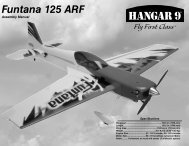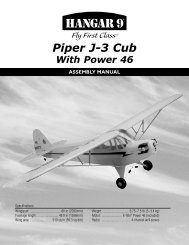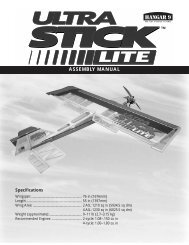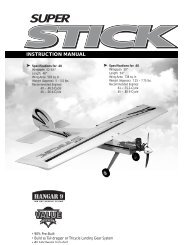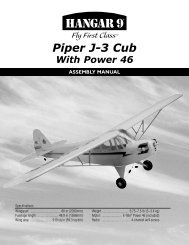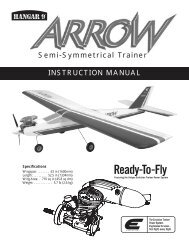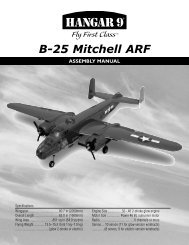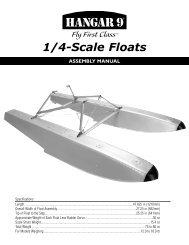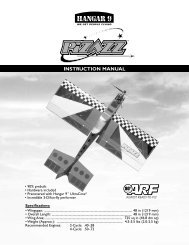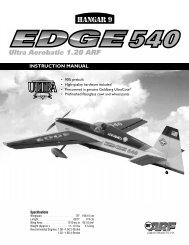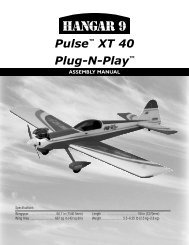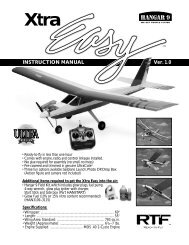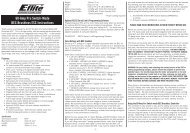Create successful ePaper yourself
Turn your PDF publications into a flip-book with our unique Google optimized e-Paper software.
Section 17: Balancing and ControlThrow RecommendationsCaution: Do not skip these steps!Recommended CG LocationAn important part in preparing your <strong>Hangar</strong> 9 ® <strong>Super</strong> <strong>Cub</strong>/J3<strong>Cub</strong> aircraft for flight is properly balancing the model. This isespecially important when various engines are mounted.The recommended Center of Gravity (C.G.) location for the<strong>Hangar</strong> 9 <strong>Super</strong> <strong>Cub</strong> and J3 <strong>Cub</strong> is 4 3 ⁄4" to 5" behind theleading edge of the wing measured at the fuselage sides.If necessary, move the battery pack or add weight to either thenose or the tail until the correct balance is achieved. Stick-onweights are available at your local hobby shop and work wellfor this purpose.Recommended Control ThrowsAileron .....................................................Elevator ....................................................Rudder .......................................................Flaps (<strong>Super</strong> <strong>Cub</strong>) ................................................Flap/Elevator Mix(<strong>Super</strong> <strong>Cub</strong>) .....................5/8" up, 1/2" down7/8" up, 7/8" down1 1 ⁄2" right and left1 1 ⁄2"down3/8" down at full (1 1 ⁄2") down flapThe following control throws offer a good place to start with yourfirst flights on the <strong>Hangar</strong> 9 <strong>Super</strong> <strong>Cub</strong>/J3 <strong>Cub</strong>. We recommendonly one rate setting for both the <strong>Super</strong> <strong>Cub</strong> and J3 <strong>Cub</strong>. As youbecome more familiar with the handling of your model, you maywish to add a second rate setting.Section 18: Preflight at the Field1. Before each flying session, be sure to range check your radio.This is accomplished by turning on your transmitter with theantenna collapsed. Turn on the radio in your airplane. With yourairplane on the ground, you should be able to walk 30 pacesaway from your airplane and still have complete control of allfunctions. If not, don't attempt to fly! Have your radio equipmentchecked out by the manufacturer.2. Double-check that all controls (aileron, elevator, throttle,rudder, etc.) move in the correct direction.3. Be sure that your batteries are fully charged, per theinstructions included with your radio.4. Completely read the instructions included with your engineand follow the recommended break-in procedure. At the fieldadjust the engine to a slightly rich setting at full throttle andadjust the idle and low-speed needle so that a consistent idle isachieved. Before you fly, be sure that your engine reliably idles,transitions, and runs at all throttle settings. Only when this isachieved should any plane be considered ready for flight.50



